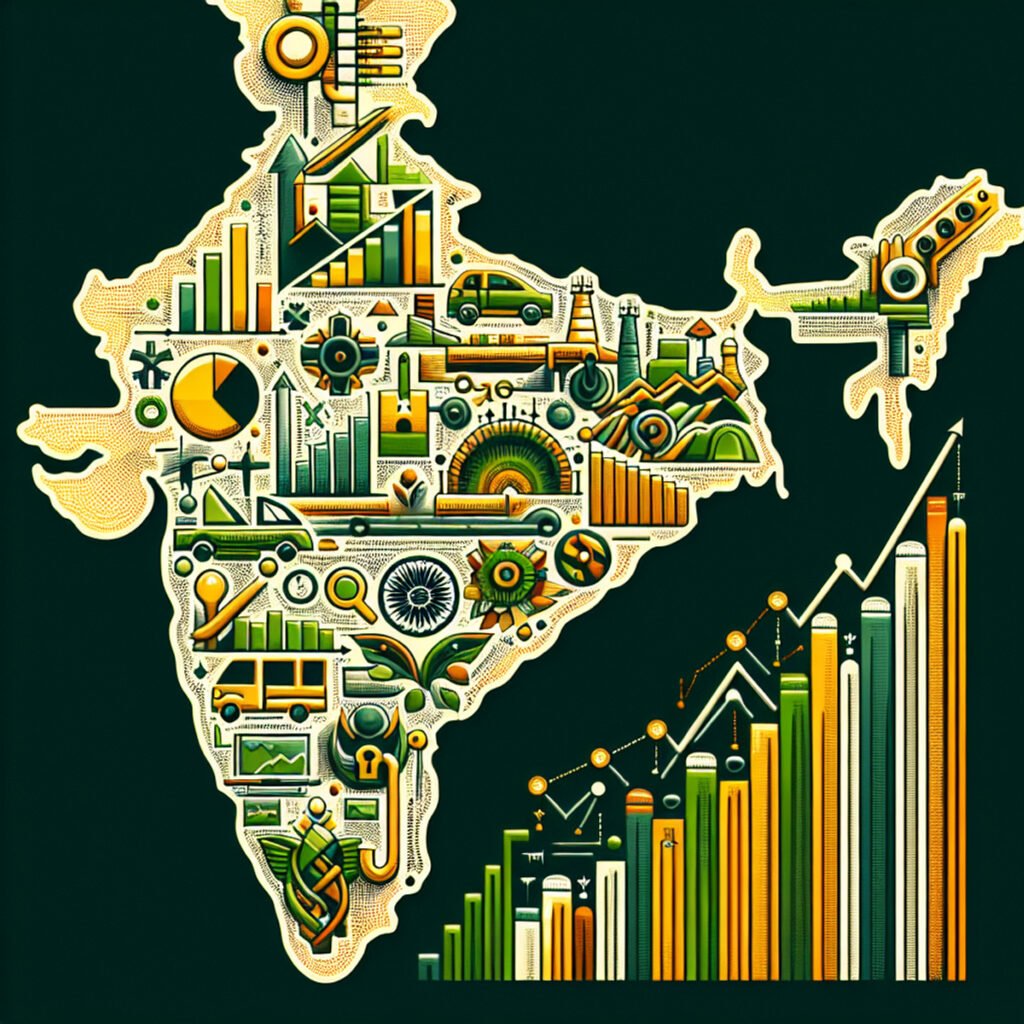Introduction
Economic planning plays a crucial role in driving India’s development and has been a cornerstone of the country’s post-independence growth. In this article, we will delve into the history, objectives, key features, types, achievements, and challenges of economic planning in India to understand its complex nature and impact on the country’s growth.
Read More: Economic Reforms in India
Economic Planning in India
What is Economic Planning?
At its core, economic planning involves the systematic allocation of resources to achieve specific goals and objectives. In India, economic planning was initiated with the introduction of Five-Year Plans in 1951. These plans aimed to address various development priorities such as poverty alleviation, industrialization, and social justice.
The Significance of Economic Planning in India
The significance of economic planning in India cannot be overstated. It has been instrumental in:
- Boosting national and individual incomes
- Mitigating income inequalities
- Balancing regional disparities
- Maintaining price stability
- Generating employment opportunities
- Developing infrastructure
- Promoting education and healthcare
Through this article, we will explore:
- The evolution of economic planning in India since independence
- The clear goals and objectives that shaped different phases of planning with a focus on resource allocation and sustainability measures
- The key focus areas of economic planning, such as productivity enhancement and infrastructure development
- The government-led economic planning process and different types of economic planning adopted in India
By understanding the historical background, objectives, and key features of economic planning in India, we can gain valuable insights into its achievements and persistent challenges. Ultimately, we aim to explore new paradigms for effective and inclusive economic planning that will shape India’s future for sustainable development.
Economic Planning in India
Read More: Economic Policy Changes in India since 1991
Historical Background and Post-Independence Development
Historical Background: Economic planning in India traces its origins to the pre-independence Bombay Plan of 1944, gaining formal structure with the launch of the First Five-Year Plan in 1951. Driven by socialist ideals, these early plans sought rapid industrialization and balanced growth to address post-independence challenges.
Post-Independence Development: Subsequent Five-Year Plans aimed at specific development goals, emphasizing heavy industries and infrastructure. The transformative economic reforms of 1991 marked a paradigm shift, blending planned development with liberalization. Post-liberalization, India’s economic planning evolved dynamically, incorporating market-oriented strategies while addressing persistent challenges like regional disparities and implementation efficiency.
Economic Planning in India

Objectives of Economic Planning in India
Economic planning in India is driven by key objectives that aim to achieve harmonious growth and inclusive development. Let’s delve into these objectives and explore the key focus areas of economic planning in India:
- Elevating National and Individual Incomes: Economic plans serve as catalysts, boosting both the nation’s overall income and individual earnings. Focused on vital sectors like agriculture and industry, they set off a chain reaction—increased investments, heightened production, and a surge in the country’s total income.
- Mitigating Income Inequalities: Economic planning acts as a roadmap to diminish economic gaps, preventing conflicts arising from wealth disparities. The primary aim is to ensure that everyone, especially those facing financial struggles, receives a fair share of the benefits from economic development.
- Balancing Regional Disparities: Economic planning targets the reduction of regional inequalities, with a focus on developing backward and underdeveloped areas. Measures are implemented to bolster both industrial and agricultural sectors in these regions.
- Price Stability: A crucial goal of economic planning is maintaining price stability, preventing drastic fluctuations and shielding the economy from the adverse effects of inflation and deflation.
- Generating Employment Opportunities: Economic planning aims to create job opportunities by fostering growth in sectors capable of absorbing a significant portion of the workforce, thereby reducing unemployment and underemployment.
- Infrastructure Development: Planning initiatives prioritize infrastructure development, covering transportation, communication, and energy sectors. Robust infrastructure is indispensable for overall economic growth.
- Promotion of Education and Healthcare: Recognizing the pivotal role of human capital in development, economic planning emphasizes improvements in education and healthcare. Initiatives include enhancing literacy rates and providing accessible healthcare services. Explore the comprehensive goals of economic planning for sustainable growth and societal well-being in India.
Read More: Problem of Unemployment in India

Features of Economic Planning
Economic planning in India is characterized by several key features that distinguish it as a strategic approach to national development. Here are seven main features.
- Socialistic Pattern of Society: Economic planning in India aims to establish a socialistic pattern of society, reducing economic disparities, ensuring social justice, and providing equal opportunities for all citizens. The ultimate goal is to create a more equitable and inclusive society.
- Five-Year Plans: Operating through a series of Five-Year Plans, economic planning outlines specific targets and strategies for development over five years. Each plan concentrates on crucial sectors like agriculture, industry, infrastructure, and social development.
- Public Sector Dominance: Economic planning in India plays a significant role in the public sector. Industries of strategic importance and those contributing to public welfare are often government-owned, ensuring the equitable distribution of resources.
- Importance of Agriculture: Recognizing agriculture’s significance, economic planning places a strong emphasis on its development. Measures include increasing productivity, enhancing rural infrastructure, and improving the socio-economic conditions of farmers.
- Decentralized Planning: While there is centralized planning at the national level, economic planning in India acknowledges regional diversity. States and local governments actively contribute to decentralized planning, addressing regional imbalances.
- Harmonizing Economic Growth with Social Justice: Economic planning seeks to harmonize economic growth with social justice, addressing issues of poverty, unemployment, and social inequality alongside economic development. Inclusive growth is a guiding principle.
- Import Substitution and Self-Reliance: Especially during earlier phases, economic planning in India emphasized import substitution to reduce dependence on foreign goods. The goal was to promote self-reliance in key sectors, reducing vulnerability to external economic fluctuations.
Read More: Meaning and Features of an Underdeveloped Economy
Types of Economic Planning
In the dynamic landscape of India’s economic planning, a nuanced understanding reveals diverse types shaped by approaches, focus areas, scope, and centralization levels. These types are instrumental in fostering sustainable economic growth, mitigating poverty, reducing inequality, and ensuring universal access to basic amenities. Let’s delve into the distinctive categories
1. Planning by Direction and Planning by Inducement
- Planning by Direction: Here, the government orchestrates resource allocation and production. It exercises control over these aspects to align with overarching economic goals.
- Planning by Inducement: In this approach, the emphasis shifts towards stimulating private investment and entrepreneurship. Incentives and market-oriented policies are the driving forces.
2. Financial Planning and Physical Planning
- Financial Planning: This type centers on the judicious allocation of financial resources to fuel economic endeavors.
- Physical Planning: Contrastingly, physical planning directs attention to the allocation of tangible resources like land, water, and minerals. Both are pivotal for fostering sustainable growth.
3. Indicative Planning and Imperative Planning
- Indicative Planning: Offering guidelines and targets, this type guides the private sector and market forces. It provides a framework for voluntary adherence.
- Imperative Planning: Involving mandatory regulations and controls, imperative planning is geared towards achieving specific, non-negotiable targets.
4. Rolling Plans and Fixed Plans
- Rolling Plans: Flexibility is the hallmark of rolling plans. Subject to annual reviews and revisions, they adapt to changing economic dynamics and emerging priorities.
- Fixed Plans: In contrast, fixed plans have a predetermined duration without mid-term revisions. They provide a stable roadmap for a defined period.
5. Centralized Planning and Decentralized Planning
- Centralized Planning: In this paradigm, the central government assumes a pivotal role in both planning and implementation. It takes the lead in steering the economic course.
- Decentralized Planning: This approach distributes planning and implementation responsibilities to lower levels of government—states, districts, and local bodies. It fosters localized decision-making.
Achievements and Criticisms
The economic planning efforts in India have yielded both significant achievements and persistent challenges. Let’s explore some of the major accomplishments as well as the criticisms faced by the Indian economy in its planning endeavors.
Achievements of Indian Economic Planning
Economic Planning in India
- Economic Development and National Income: Economic planning has acted as a catalyst for a substantial increase in India’s national income. The average growth rate, which was a mere 0.5 percent per year before the planning era, reached a commendable 5.1 percent between 1950-51 and 2020-21. Despite the setback in 2020-21 due to the COVID-19 impact, a recovery is anticipated with a projected growth rate of 8.5 percent in 2021-22.
- Surge in Per Capita Income: Economic planning has reshaped the trajectory of per capita income growth, achieving an average annual growth rate of 3 percent. In the Twelfth Five-Year Plan, per capita income surged at an impressive rate of 5.7 percent per year. Although a temporary decline is expected in 2020-21, a recovery to 7.5 percent is projected in 2021-22.
- Enhanced Capital Formation: Capital formation, contingent on savings and investment rates, has witnessed a remarkable ascent over seven decades. From 8.7 percent of GDP in 1950-51, the capital formation rate soared to 32.2 percent in 2019-20, showcasing the resilience and vibrancy of the Indian economy.
- Agricultural Transformation and Green Revolution: Economic planning facilitated institutional reforms in agriculture, paving the way for the Green Revolution. Since 1966, advancements in farming techniques have propelled food production fourfold, from 550 lakh tonnes in 1951-52 to 3,107 lakh tonnes in 2020-21, exemplifying the success of these efforts.
- Infrastructure Development:
Infrastructure witnessed notable progress during the planning period, covering transportation, communication, irrigation, and electricity production. Power generation capacity surged, and substantial developments occurred in roads, railways, ports, airports, telecommunication, and the financial sector.
Economic Planning in India
Challenges in Indian Economic Planning
Economic Planning in India
- Limited Progress in Standard of Living: Despite the noble goal of improving the standard of living, the current scenario tells a different story. According to Maroon’s Tendulkar, a substantial 21.9 percent of India’s population still grapples with poverty. The ambitious Garibi Hatao program initiated seven decades ago, has fallen short of achieving significant success, leaving the expectations of the poor and the middle class largely unfulfilled.
- Rising Prices: The envisioned goal of maintaining price stability has faced challenges as inflation rates witnessed an upward trajectory. Schemes aimed at curbing rising prices have not yielded the desired results. With an inflation rate of 9.50 percent in 2013-14 and 2 percent in 2021-22, the adverse impact on the poor and low-income groups is evident.
- Unemployment Challenges: Paradoxically, unemployment has surged instead of declining during the implementation of successive five-year plans. Anticipated as a period of job creation, it has instead seen an increase in unemployment. The promotion of capital-intensive technology over labor-intensive methods has exacerbated the unemployment crisis, with registered unemployment soaring to 4.21 crores in December 2019.
- Stagnation in Agricultural Growth: The agricultural sector, often considered the backbone of the economy, has not received the priority it deserves in the plans. The Green Revolution, primarily focused on wheat and rice, has failed to bring comprehensive benefits, leaving many states untouched. Inadequate development of irrigation facilities and reliance on rain has kept agricultural productivity low, with many farmers in villages remaining landless.
- Widening Income and Wealth Disparities:
Rather than mitigating, economic plans have witnessed an exacerbation of inequalities in the distribution of income and wealth. The rich have become richer, while the poor have slipped further into poverty. This disparity is not confined to the industrial sector but permeates into the agricultural domain as well.

The Way Forward
Addressing the ongoing challenges and embracing new paradigms for effective and inclusive economic planning in India’s future is crucial for sustainable development. Here are some key points to consider:
Poverty and Standard of Living Improvement
Despite significant progress, poverty continues to affect a substantial portion of the population. To tackle this issue, economic planning should focus on targeted interventions such as:
- Skill development programs
- Job creation in sectors with high labor absorption capacity
- Social safety nets
Additionally, emphasis should be placed on improving access to:
- Quality education
- Healthcare
- Basic amenities
Unemployment Increase
The preference for capital-intensive technology over labor-intensive methods has contributed to rising unemployment in India. To address this challenge, economic planning should prioritize policies that promote job-intensive sectors such as:
- Manufacturing
- Services
- Agriculture
Encouraging entrepreneurship and fostering a favorable business environment can also stimulate job creation.
Sustainable Development
As India strives for economic growth, it is essential to ensure that development is sustainable and environmentally friendly. Economic planning should incorporate measures to:
- Mitigate climate change impacts
- Promote renewable energy sources
- Encourage resource-efficient practices
Balancing economic growth with ecological conservation will contribute to long-term sustainability.
In conclusion, economic planning in India plays a vital role in driving the country’s development agenda. While acknowledging the achievements thus far, it is crucial to address persistent challenges and adapt to changing dynamics. By focusing on poverty alleviation, improving standards of living, combating unemployment, and embracing sustainable development principles, India can chart a path towards inclusive and equitable growth.
Economic Planning in India
FAQs on Economic Planning in India
What is Economic Planning?
Economic planning is a systematic and coordinated effort by a government or organization to allocate resources, set priorities, and formulate policies to achieve specific economic goals. The primary objective of economic planning is to promote balanced and sustainable development, addressing issues such as poverty, unemployment, and inequality.
What are the Objectives of Economic Planning in India
The Main Objectives of Economic Planning in India are:
- Increase in National Income and Per Capita Income
- Mitigating Income Inequalities
- Alleviating Regional Inequalities
- Price Stability
- Employment Generation
- Infrastructure Development
- Promotion of Education and Healthcare
What are the Features of Economic Planning
Economic planning in India is characterized by several key features that distinguish it as a strategic approach to national development. Here are seven main features.
- Socialistic Pattern of Society
- Five-Year Plans
- Public Sector Dominance
- Importance of Agriculture
- Decentralized Planning
- Harmonizing Economic Growth with Social Justice
- Import Substitution and Self-Reliance
What are Types of Economic Planning
In the dynamic landscape of India’s economic planning, a nuanced understanding reveals diverse types shaped by approaches, focus areas, scope, and centralization levels.
- Planning by Direction and Planning by Inducement
- Financial Planning and Physical Planning
- Indicative Planning and Imperative Planning
- Rolling Plans and Fixed Plans
- Centralized Planning and Decentralized Planning
Why do we need a planned economy?
In the intricate fabric of India’s economic landscape, the necessity for comprehensive economic planning stands out as imperative for sustainable development and inclusive growth. The main objective of economic planning in India is to reduce the number of people who live below the poverty level and make a stable economic condition for the entire nation.
What are Achievements of Indian Economic Planning
The Main Achievements of Indian Economic Planning are:
- Economic Development and National Income
- Per Capita Income Surge
- Enhanced Capital Formation
- Agricultural Transformation and Green Revolution
- Industrial Advancements
- Infrastructure Development
Failures of Economic Planning in India
These are Failures of Economic Planning in India:
- Limited Improvement in Standard of Living
- Escalation in Prices
- Unemployment Challenges
- Stagnation in Agricultural Growth
- Widening Income and Wealth Disparities
- Administrative Inefficiency
- Targets Falling Short


[…] Read More: Economic Planning in India […]
[…] Read More: Economic Planning in India […]
[…] Read More: Economic Planning in India […]